The history of the RaspberryPi microcomputer

Congratulations to the developers RaspberryPi - they recently broke the barrier of 2 million motherboards sold .
And in honor of this momentous event, we offer the translation of a speech by Eben Upton (PYCON US conference March 2013).
')
Performance
Thank you all! My name is Eben Upton, and I run the UK-based Raspberry Pi Foundation. We make small computers for children.
I would like to talk a little bit about what a Raspberry Pi is. This is a very big story about the Raspberry Pi itself and why we are doing it.
For me, the Raspberry Pi is a seven-year journey, since I was, as they say, head teacher at Cambridge University. Now the role of the head teacher is to organize the teaching of students in any subject in one of our thirty colleges, as well as to ensure a sufficient number of students in the future. Every December, high school students come to us. Previously, many students came to enroll in our course.
When I came to Cambridge in 1996, we had exceeded the limit with a share of 6: 1, so to get to the computer science course, you had to fight, you had to beat the other five candidates. And these five candidates are most often people who have a deep understanding of what computers do. These are those who programmed from the age of 10. They probably had Commodore 64 or Timex. In the UK, there was still the BBC Microcomputer, and it was with him that I grew up. These were the people who bought these cars for children to play computer games on them. And, maybe, they created or bought these cars for study.
But all these machines had something in common: when you turned them on, they made a “beep” sound (well, I had a “beep”) and showed the program line (expecting you to enter a command). And so the first thing you had to do if you wanted to play games or run a text editor for homework is to choose not to program the computer.
This means that any British person of my age who had inclinations or, simply, an interest in programming, had the opportunity to satisfy this interest (since this was the default when the computer was turned on) could program many hours a day, developing their own skills. This means that almost everyone I knew at school could at least write a simple 2-line program:
10 PRINT “I AM THE BEST” 20 GOTO 10 ... or maybe something more indecent. Then they went to the computer store, drove the code in all the cars, and pressed 'Enter' on all the cars and ran out the door. It was a simple 80s, we had fun, how could.
The result was a huge stream of smart and talented children who came to us at the age of 18. Courses at Cambridge are quite famous for their short terms: the better the university in the UK, the less time you spend there. So, for the three-year course, we had 60 weeks to turn a high school student into someone who could start working on a 3-year doctoral [3-year PHD program]. This means that it was very useful for us to rely on the already existing level of skills and a certain level of knowledge of those who came to us, and in fact, what we had to do was convince the children that they did not know anything. We had a terrific tool for this - “functional programming” - Standard ML .
It was necessary to "bang" these children (I was one of these children); they broke stereotypes of the first eight weeks of the course. And when they lay on the floor, whimpering, we understood that they could already be started to teach the things they needed.
People absolutely need to know functional programming. By the time I defended my doctoral thesis and began interviewing people in 2005, the picture had changed radically. If earlier we had about 500 candidates for 80-90 places, there were only 200-250 of them. Of course, it was a good share, but it still became smaller. We started to think that we could not recruit 80 or 90 people. But, while we could find these people in courses that were undoubtedly as smart as those who studied in the mid-90s, they lacked the built-in hacker knowledge about what the computer does. We had to spend a lot of time starting these 60 weeks to tune students to a level that used to be taken for granted.
In 2006, a small group at the university began to wonder why this happened, and whether we could do something about it. The theory was that the 8-bit machines that existed when we were children disappeared. This ecosystem was destroyed by game consoles: they are not only non-programmable, but they are designed to be NOT programmable. A specific business model encourages the creation of non-programmable pieces of hardware in order to generate revenue from the development of the platform.
Then came the PC. A PC is a highly programmable hardware like a programmable environment, a PC is much more sophisticated and user friendly than the machines that existed in the 80s. What has changed is an architectural choice. If you bought a PC [it worked out of the box], and you had to make an effort [choice] to start programming on it, you had to make an effort to install any program, or find documentation. And this small energy barrier was enough to significantly reduce the number of skilled candidates.
We thought that this niche exists, and we need to fill it. We have an idea to fill this niche, and it consists of four parts.
First of all, it must be something programmable.
Secondly, it should be interesting. We remember why children bought these machines in the 80s - I myself bought similar machines in the 80s, but for programming, the fact is that they bought computers for games and school work, so there had to be something else . It should be more than just a programmable device. For us, “interesting” meant games, graphics, and video.
Also, it should be strong. We needed something small and reliable, something that you can shove in a school backpack, pull out many times and not hurt.
In the end, we needed something cheap. We knew that we needed to ask people to buy these cars, but they should not be expensive. Our idea was to set the price of a regular school textbook, because you can ask the children to buy a textbook. We chose a price of $ 25, which shows that we did not know how much textbooks cost. If we knew how much textbooks cost, we would not have problems with engineers for several years :)
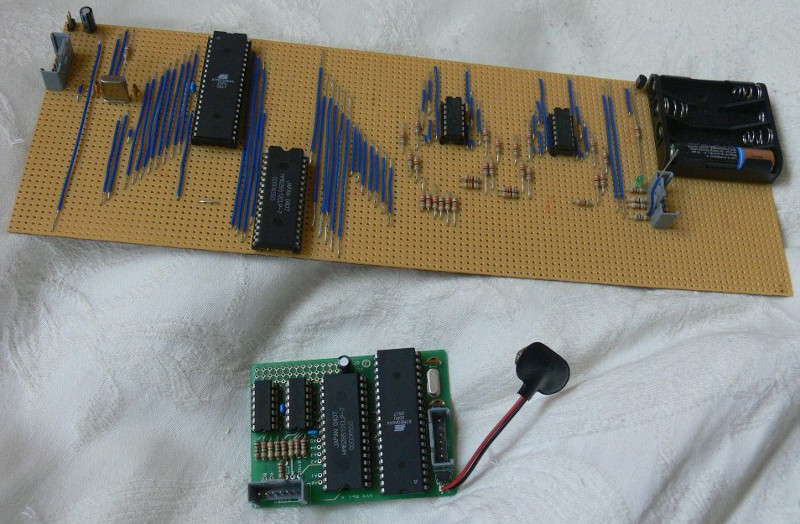
We set the bar at $ 25. This is the cheapest model Raspberry Pi. We spent a lot of time trying to figure out what we could do for $ 25. The first thing we did was look like the Arduino family, with which I think many of those present worked. It was based on microcontrollers. You could insert this microcontroller into an old standard-quality TV, and you could have a microcontroller similar to 8-bit Atmel or ATmega. But we did not succeed in these tests. One of the wonderful things was that you could make such a device on a breadboard [veroboard]. You could get to work on a rainy day, and in the evening you could get a computer. And it definitely fits in our declared $ 25, but it may not be interesting for children, can it? This is interesting to me because I already know how to program, and I like computer toys [geeky toys]. But they should be interesting for children. So we threw this idea.

It was around this time that I went to work for Broadcom, and I still get paid a salary, although now I spend more time with this device. We made chips for phones that cost about as much as microcontrollers cost, and I was amazed that if you are a mobile phone company, $ 10 differs from $ 10 in Digikey [electronic components store] in terms of performance. And our small group decided to see what we can do on the basis of one of the platforms for mobile phones.
Somewhere in 2008, in our hands turned out to be a device, invented in Cambridge, based on a graphics processor of a mobile phone, and it was just the way. It was a device that did not have an open processor, inside it was a proprietary RISC core. We ported C Python there. We got what we wanted for so long. It was a machine that was launched under a known language for learning, in this case Python. And she looked cool. It fit in $ 25, it could play the video as 720p, it had a fairly powerful graphical process, we added Python bindings for all these features. It was a really cool little platform. You know, we thought it was a great start. We thought we needed an organization to advertise this car. We came up with the name 'Raspberry Pi', where Pi means Py in 'Python'. Yes, incorrectly written, but I defended this spelling for the past four and a half years. It seemed to us that Pi would have been a terrific logo, and had never taken advantage of this opportunity, but in the end we staked out this name.
And then off we go. But one of the problems we encountered was that we had to do everything ourselves - it was a very closed platform. We built a popular language there, but we had to write everything ourselves: our network drivers, drivers for SD-cards and all that, so we didn’t reach the end. We were very lucky that in a couple of years [in Broadcom] a new chip for mobile phones was produced, and I managed to put the ARM11 at the forefront of the chip - ARM11 ... These are the advantages of working in a chip development team.
"We certainly need an ARM11 in this chip for unexplained business reasons [unspecified business reasons]."
We got this chip, and it was beautiful: we got what we wanted. It was almost an open platform on which Linux could run, which meant that we could afford this investment in the development of a real operating system, for which there is no need to pay.
But we still thought too narrowly. The only thing we wanted was to reach the level of 250 candidates a year who would like to study at Cambridge at the Faculty of Computer Science. Maybe add 80 or 90 people there to learn assembly language. That would be a good result. Since we all suffered nostalgia - I do not know if there is anyone here who has come across a machine called the BBC Microcomputer? It was an educational microcomputer in the 80s, sponsored by the BBC. So, our group worked with BBC Micro, and we were all quite romantic, so we thought it would be cool to stick a BBC sticker on the car. We started calling it BBC Nano, since we never wanted the brand Raspberry Pi. We started asking the BBC: “Can we stick your logo on the car?” And they continued to say “no”, there were many reasons for this.
Our last attempt took place in May 2011 (almost 2 years ago): we went to Rory Sellan-Jones, BBC chief correspondent for technology, and asked him again, he told us no. But then he added: “Although I think this is a great idea. Can I make a video with one of you, and could you talk about the idea of the prototype? ”
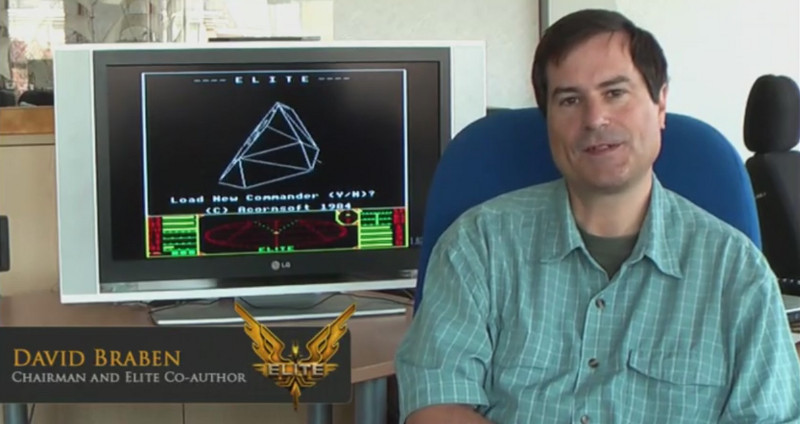
One of my colleagues, David Braben, one of my comrades - I don't know, did anyone play the Elite computer game? Who lost all his childhood in this game? So, this is David's fault. There was a 45-second video with him. He simply stood with something not at all like the Raspberry Pi, and talked about the Raspberry Pi project.
Video [for some reason no audio]
Videos watched 70,000 times on YouTube in two days. And it was a wonderful two days for me: I sat at Broadcom at work and did nothing. I just sat there, constantly pressing F5.
You saw an episode from The Simpsons, where Homer buys the console home and replaces all the functionality of one of the toy birds. That's about the same way I pressed F5. My “how popular you are” counter continued to rise, I felt great.
At the end of the second day I came home, I was really inspired, and here we sat down with my wife Liza to dine, sat down to dine at the table against each other, and then we suddenly realized ... - "Oh, damn!" [oh, shit!] - we realized that we promised 600,000 people that we would build a 25-dollar computer - not knowing how to do it ...
And therefore, the 2011th year was very difficult for me, as it was necessary, first of all, to understand how to achieve this price. If you add up the price of all the chips, something like this happens, but in Raspberry Pi there are about 180 components. Some of them are worth one cent, some are two, some are 10, and they can really add to the price. We have long tried to figure out how to lower the bar to $ 25 or to $ 35, but this is already with Ethernet and with several USB connectors.
By the end of the year, we had something that just came at a price. It was fantastic. We thought about 600,000 people and thought, "Well, most of them just walked past, they really do not want a Raspberry Pi." We came up with an excellent business model (I just finished an MBA, so I knew everything about business models), and I thought, “We will release 10,000 Raspberry Pi boards, post information on a website like an online store, people will start to buy them, and then, in a few months, we will run out of 10,000 boards, and we use this money to make subsequent boards, it will be cool! ”
But then danger signals appeared: the traffic on the site was huge, the number of people on the forums increased. And in order to leave people interested, we uploaded the contents of the bootable SD card to the site, since the machine was started from it. It was an early beta software with bugs, a simple firmware, you could run it on Qemu. This version was downloaded 50,000 times. It was the moment when we realized that there are 50,000 people of our fans, how severe they are, that they are ready to download even the most buggy alpha version of the operating system for a computer that does not yet exist.
Then we thought that our 10,000 models would be dismantled in just a week, and their creation lasts three months, so we will have problems. We were very lucky, since we found two companies in the UK: Premier Farnell and RS Components. They operate here under the trademarks 'Newark' and 'Allied'. Two huge distributors who had the same goals. Their customers are engineers, they have an interest in building a strong engineering base in the country. Therefore, they had the same goals as ours. Therefore, they were ready to help us out, not just spreading the fees, but producing them for us. They were ready to provide capital, they were ready to provide supplies and support from customers. In January 2012 - two months before the launch, we turned from a fixed-capital institution into a company that issued licenses for intellectual property [IP licensing company]. We were owners of the board drawings, we owned the RaspberryPi brand, and we issued licenses (for a fee and a brand) to these two companies, and they did the hard work for us. That's what helped to ensure scalability.
We are very fortunate that we did it - because we had 100,000 orders on the first day (April 12, 2012). The answer to our question was: "15 minutes." That was cute. A year has passed. We sold the millionth Raspberry Pi last month.
I need to pretend that I called the number 1 for a reason, right? So, the unit is one million cars sold. [at the beginning of the speech, the number 1 on the screen was highlighted on Pi]
It was a wonderful year, and one of the most important things this year for the first six months was that our site had a lot of licensed programs that we had been doing all this time. For the next 6-9 months, people who are knowledgeable about computers started writing about us.
The last 3-6 months, the nature of the submission to our site changes. There are adults who work at Pi, and children want to work on it too. This is a very good sign.
I'll hit you right now. (speaks backstage) Can I return the slide?
(Pi appears - 3.1415, the number 15 is highlighted)
15 cool pictures. I could not do fifteen, but it will be very fast.
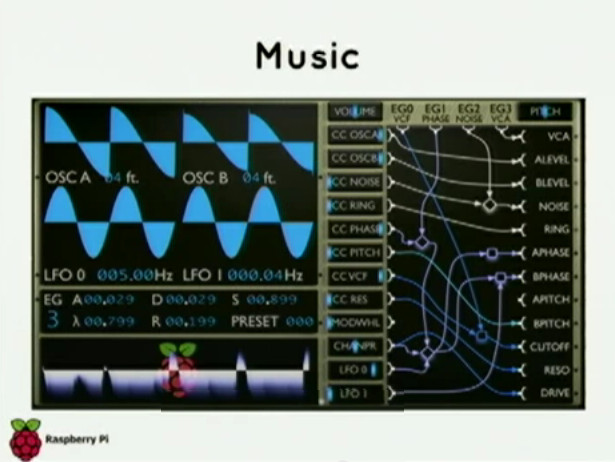
We did not expect people to do projects. I do graphics and I think many people would like to make graphic demos for the platform. If there are experts in this room, make some Pi demo and make me happy. But everything that people have already done for Pi was completely unexpected for me. Here you are, great work.
People use this platform to create music. This is an analog-to-digital synthesizer, which you can download, called ... The name flew out of my head, but you can find out about it on the website raspberrypisynthesizer.blogspot.ru .
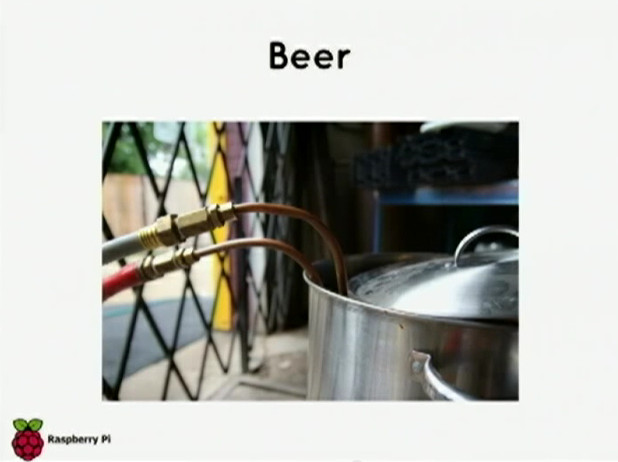
Beer! It turns out that there are many people who love computer programming and beer to the same extent. You will not believe it, but some people, having started working with the Raspberry Pi, decided to make their brewing station correctly. There is a program called BrewPi, this is an open platform. I think it is written in Python, Arduino and for Raspberry Pi. This is a system that analyzes the "microvariation of beer" on the Raspberry Pi.
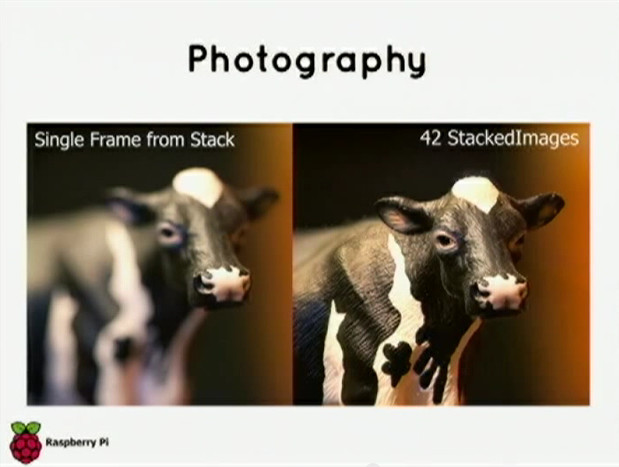
The photo. I liked it. If you want perfect macrophotography, there is a process called “focus reduction” in which you take pictures twice by focusing the camera on two objects and then bringing them together. Usually you need software worth £ 1000, and here everything is done with a simple scanner, camera and Raspberry Pi. Very cute.

Oh yeah, games. Around Raspberry Pi there is a huge society of fans of retro games. Raspberry Pi is powerful enough to emulate the era of computers, on which I grew up and which destroyed the era of computers. I constantly complain about it. Here you are, Super Nintendo, damn you!
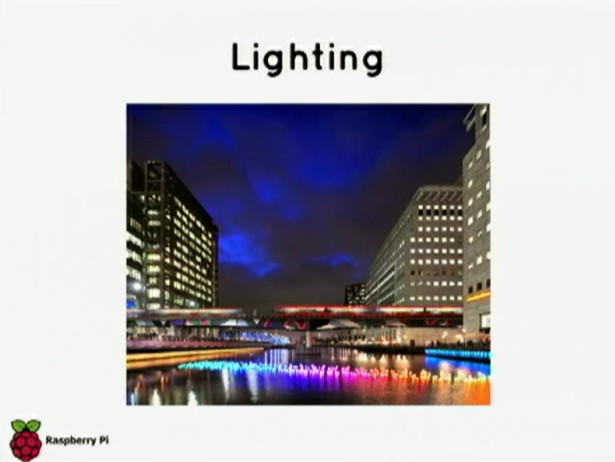
Now about the lighting. I inserted this slide because it's incredibly cute. On the Thames there is a lot of paper, there is probably no plastic boats. There is a small jetty on the Thames, called Canary Wharf, there are many UK financial services. There is a string of boats to which you can connect, type the text, and the boat will change its color. Such installations have become popular for the Raspberry Pi.
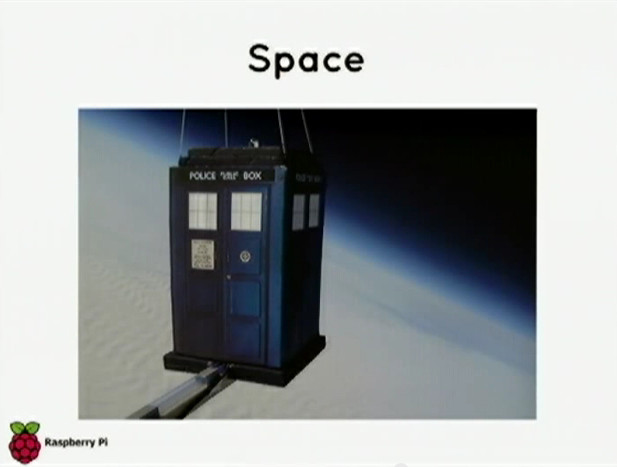
Oh, this is my favorite! This is Doctor Who, Cosmos and Raspberry Pi in one. One gentleman, Dave Ackerman, whom I met for the first time on Thursday evening, but I have known him for a long time, he installs cameras on weather probes and sends them to a height of 40 kilometers and takes photographs. He does this with camcorders and simple digital cameras. A year ago, immediately after launch, he started doing this with Pi. He made these wonderful pictures of the Earth from a height of 40 kilometers, and he continues to do incredible things, such as a small polystyrene TARDIS in space.
It is important to note that this allows the “Space Program” with an achievable budget to reach the level of each elementary school in the world. I challenge all children not interested in science, technology, engineering and mathematics so that they can launch the TARDIS into space.

We have the same journals that came out in the 80s, with the same uppercase codes as in the 80s. Magazine with Python codes. There is something in it, because the Internet is a great helper for people to learn how to write on a program. I remember, as a child, playing Elite, I wanted to write a small 3-D game, I wanted to draw lines. I knew that there was a Bresenham algorithm that allowed me to draw these lines. My father was a professor at a UK university, and I had access to a university library. Could I find there about the Brezenham algorithm? Could it? Damn it. And now I can find out about this algorithm, just scoring it in Google.
But the great thing is that when you type something instead of just downloading it from the Internet, there is a feeling that passes through your eyes, into your brain and comes out of your fingers, this is more than just downloading and running. Usually, when you write code and make a mistake, you get a “learning opportunity”. I remember these “opportunities” in the 80s.
Here is a free magazine called The MagPi. I hope that in the future we will print them. While this is an electronic version for the first eight numbers, it is published every month. Soon it will turn into a printed version for which you can subscribe.
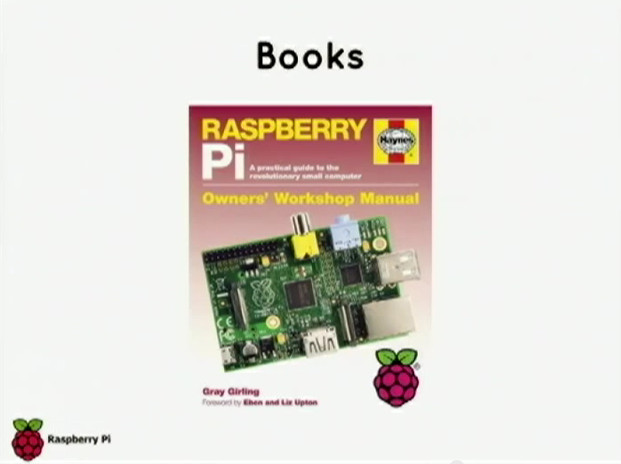
We have books. I don't know if you have the Haynes textbooks. Yes?Well, the Haynes machine textbooks were in vogue in the UK when you opened the hood, and there was a large piece of metal on which it says "if you open, then the warranty is not subject to." Haynes had to go through this transition and they survived thanks to such textbooks as the “Haynes Textbook for the Space Shuttle” and “Haynes Textbook for the Child”, now they have made such a textbook for the Raspberry Pi, so we are watching the developing ecosystem around Pi, and this is very it is gratifying. We even have one O'Reilly book, which means "you did it."
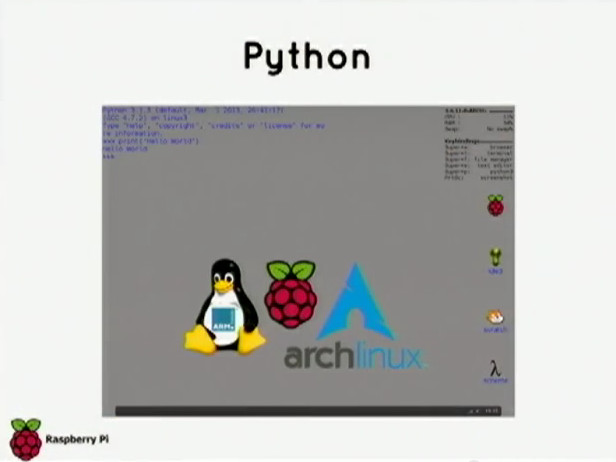
Here's a cool thing. This is a programming language called Python. One guy figured out how to run Python on the desktop of his computer. You can focus the cursor on the desktop and start writing in Python. This is how people approached the primitive experience that I mentioned earlier, and this is actually cute.
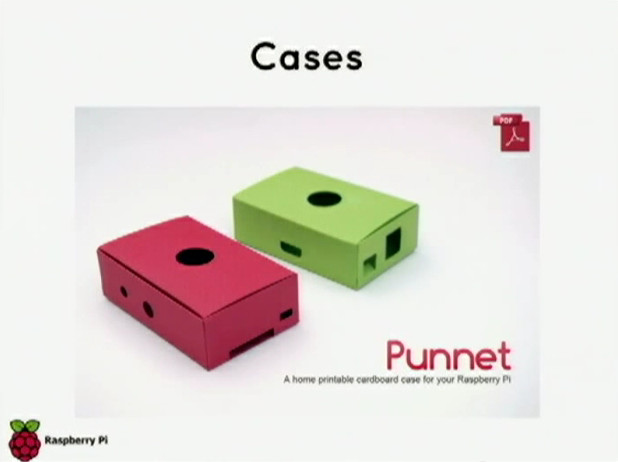
Shells - we thought to make about 1000 of these, at the beginning, and about 10,000 after. We did not think that we would make enough templates for them, so we did not make a case. This meant that we left many values in the ecosystem. Many people began to make cases for Pi, even a few accessories. Cases would ideally complement this range. They covered the entire market. And this is the lower threshold of the market, because it is .PDF. You just need to print the template on the thickest paper that you can find and insert into the printer without breaking it, then roll it up and you will have a case! And it does not even ignite, which is not bad. I like it, like a basket.

And here is another example of a steep hull - based on LEGO. We had the idea of creating a computer the size of a credit card, it was our way of focusing on the small size and ease of communication. It can be said that this is a computer the size of a credit card, but in reality it is not so, because I didn’t pay attention to the guy who was involved in the development of the board, this is my friend Pete Lomas, so it is one millimeter more than necessary. But thanks to some happy coincidence, the abscissa and the ordinate of the board turned out to be equal to the usual LEGO part, very, very close. And such LEGO cases are now full. This idea occurred to a girl named Beese. She is 11 years old and she has posted educational materials on her website. Now there is a site with a store of non-standard LEGO sets, you can buy them. Since Beaz made it all up, she gets a fee,and since she is 11 years old, she is given this fee in the form of LEGO. Now she has more LEGO than me.
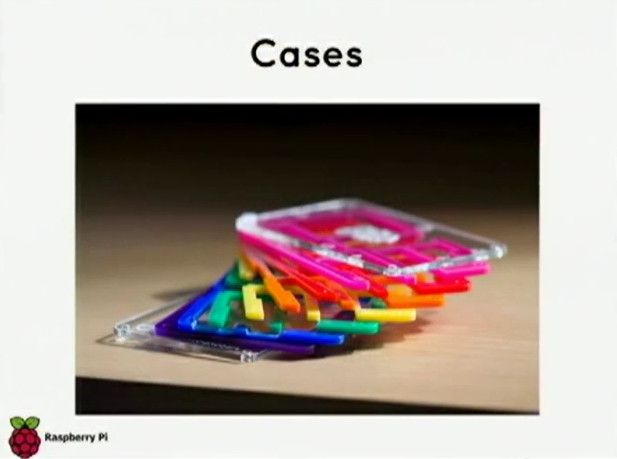
And here, on the other hand, Pibow. Daughter Jessie got a terrific case for her Raspberry Pi. This is Pibow. It is made by the person who designed our logo. This is a stack of pieces of plexiglass. The most beautiful computer case I've ever seen.

Here is some proof that children learn to program in Raspberry Pi. This guy's name is Mikey. You cannot see it because it doesn’t get into the frame, but it learns to program in Scratch, the programming language that we created. We are currently spending a lot of money to coordinate Scratch with Pi.
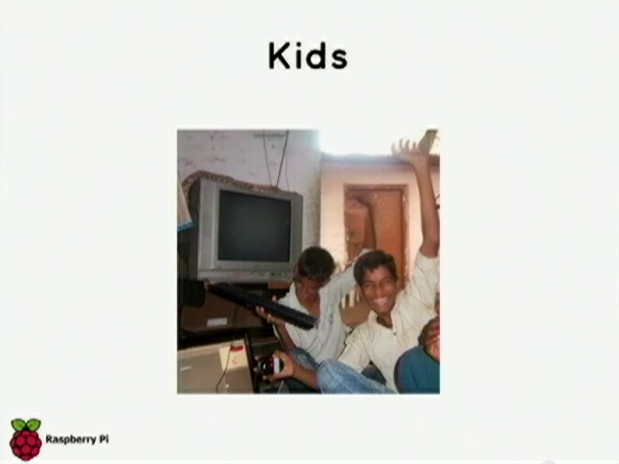
We had a very narrow view: we thought that this would help us with the problem at the University of Cambridge, but it turned out that children all over the world want to use the program. Here are the guys from Uttar Pradesh, India. In the lower left corner you can see that they use Scratch in order to learn how to program. We are sent many similar photos. When we have difficult days in the development of Raspberry Pi, and there are not so many of them, this kind of photos raise our spirits and help us advance, because they show what we should do with this small computer.

We have Minecraft. I do not think I need to say anything else. I said that a clue was needed here. You need to hook the children in the world of computers. It is clear that many children love to play Minecraft. Mojang helped us a lot, as they made a pocket version of Minecraft called “Minecraft Pi Edition”. The wonderful thing is that in this version there is a small “nest” to which you can link any programming language (guess which one is most used), and then write text commands to interact with the world. You want to build a house and start "brick, brick, brick ...". Or you can open a window with Python and write:
for x in range(10): for y in range (10): brick() And you will have a small floor. And this is a very quick response. This allows children to find what they need.
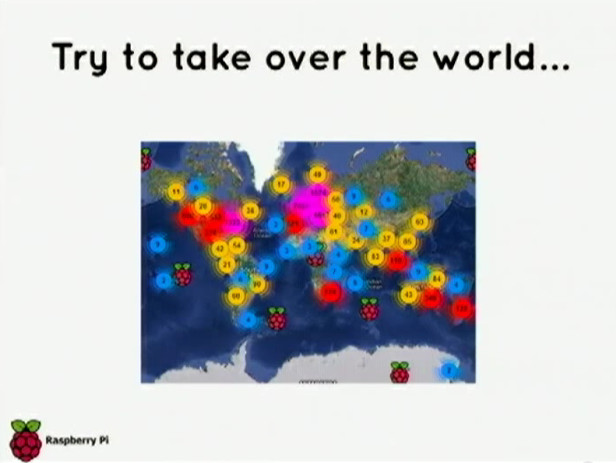
We are trying to take over the world. “What are we going to do tonight, Brain?” This is a great map created by Ryan Walmsley, who at the time was 14 years old. This is a redesigned Google map, self-registering, it shows where the Raspberry Pi is currently located. You can be sure that we left the comfort zone in Cambridge, there are few in the UK and a lot in North America. North America is currently the largest market for us in the past three months. Also there is the largest base. This is fantastic, we did not even expect that you will be so much.
There are small chances in South Africa, Australia and Asia. I think that we will be able to sell large quantities in South America and India, but we are still getting there. We have plans for them.

And here is Wales, where I come from. When we started developing the Raspberry Pi, we did what we did everything: we went to China and built. We started with China, and a few months later we received a call from Sony, who have a factory in Wales, and said: "You know, we can build a Pi for the price you can afford." Last September, we developed Pi in the UK at the same price at which we built them in Shenzhen. This is very important to me because I was born 10 miles from this factory. South Wales, like many areas that are industrial centers of the developing world, has enormous economic problems. And the ability to develop the cheapest computer in the world in Wales is a terrific sign for all those who care about the manufacturing industry in the developing world. For me personally, this is very important.
[again, the number pi on the slide, highlighted 4]
Four.Four things about Python, four reasons why Python is important to us. Our name. We got the name from Python, and I’ll protect my whole life the opportunity to write the name “Python” just like that, but yes, we are indebted to them.
We use their chip. This is the 2835 Broadcom chip, which I developed as a team for the GPU. We created the whole machine under Python. When we created processors for shaders, we developed a multimedia IP in a chip in Python, because it is a hundred times faster than transferring data through Verilog, since these tools are simply better. We had an idea: “Why are software tools much better than CAD?” Because programmers show what their own company can. So the main engineers are doing the same.
Our software. Python and many other programming languages have helped us make an unusual ARM / Linux environment with a very strong software base that can be run in a regular X86 world.
And finally, our language for learning. We support many languages. For small children we have LOGO and Scratch. We will also support C and C ++ for those who want to be closer to the hardware. Python helps us create a story that we can tell children. We tell them: "Learn this language, in which Hello, World is just a text ('Hello, World'), and then you will go along a" curved line "that will lead you to other programs." There will no longer be a gap between how you write a two-line program to annoy people in computer stores and how you will become a professional software engineer. We think that this is very important, because if there is a gap in this curve, people fall into it.
I am almost done.
Pypy. We are big PyPy fans. I think this is a great idea. I was a frequent user of Psyco before, these programs are really useful and important. We do not have such a big performance on the Raspberry Pi, so we make all our efforts to squeeze everything we can from this platform. Of course, PyPy will be a big part of our future.
That's all.I think that's all I wanted to say. Thank you very much for your time, thank you for the warm welcome. Please go to www.raspberrypi.org and talk about what you have done with your Raspberry Pi.
From the editor
I would like to thank Maxim Kalinichenko, who has already completed the second translation. To support the initiative - we decided to allocate him from our hackspace MakeItLab - RaspberryPi microcomputer :)
By the way, this is what he commented after the translation:
Finished translating by Raspberry Pi. It was a great gig.
It was a difficult and long translation. I don’t know if I could cope without a text or not :) Most likely, yes, because the topic is interesting. Eben told everything is fine and accessible.
I even wanted to learn programming in Python, to be honest!)
I know how to program in Pascal a bit, but this is absolutely the basics, for I was self-taught. But Python would like to master. I do not know why, but just very interesting.
Thank you for such an interesting video!
So I express my gratitude to Andrew McBrearty, who kindly agreed, and typed the English text of the speech.
TheMagPi Translation
By the way, the Russian translation of Eben Upton’s speech took more than half a year - several people started, but only Maxim was able to complete the translation completely (he took up the translation in early November).
There is a suggestion - in order for translations on the subject of RaspberryPi (teaching materials for schoolchildren) to appear more quickly - to collect a certain fund.
For example, you can make a crowdfunding campaign to raise funds for the translation of The MagPi magazine - I spoke with the editor - they are not against the translation into Russian. This is a great magazine for beginners to program, already 18 issues.
In order to clarify the situation - I created a web form for the surveywhere you could note your intention to participate in the campaign. According to its result, we will decide on the start of the campaign. Thank.
Source: https://habr.com/ru/post/202764/
All Articles